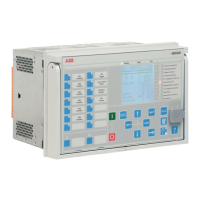3.13.2.5 Self-supervision
Each input sample is validated before it is fed into the filter algorithm. The samples
are validated by measuring an internally set reference current immediately after
the inputs are sampled. Each RTD sensor type has expected current based on the
sensor type. If the measured offset current deviates from the reference current
more than 20%, the sample is discarded and the output is set to invalid. The invalid
measure status deactivates as soon as the measured input signal is within the
measurement offset.
3.13.2.6 Calibration
RTD and mA inputs are calibrated at the factory. The calibration circuitry monitors
the RTD channels continuously and reports a circuitry break of any channel.
3.13.2.7 Limit value supervision
The limit value supervision function indicates whether the measured value of
AI_INST# exceeds or falls below the set limits. All the measuring channels have
an individual limit value supervision function. The measured value contains the
corresponding range information AI_RANGE# and has a value in the range of 0 to 4:
• 0: “normal”
• 1: “high”
• 2: “low”
• 3: “high-high”
• 4: “low-low”
The range information changes and the new values are reported.
AI_RANGE#=1
AI_RANGE#=3
AI_RANGE#=0
Hysteresis
Val high high limit
Val high limit
Val low limit
Val low low limit
AI_RANGE#=2
AI_RANGE#=4
Y
t
AI_RANGE#=0
Value Reported
Value maximum
Value minimum
Out of Range
Figure 45: Limit value supervision for RTD
The range information of “High-high limit” and “Low-low limit” is combined from
all measurement channels to the Boolean ALARM output. The range information
of “High limit” and “Low limit” is combined from all measurement channels to the
Boolean WARNING output.
Basic functions
1MRS757644 H
122 620 series
Technical Manual

